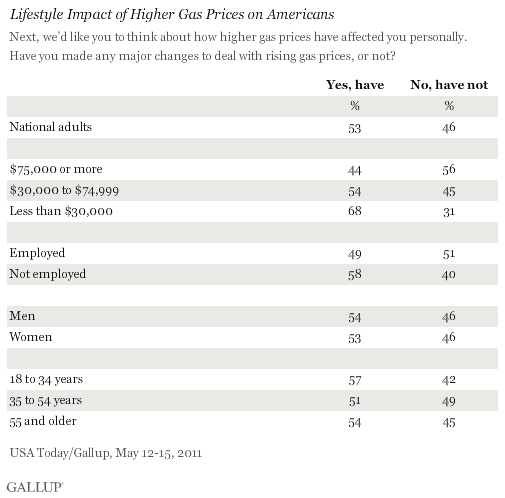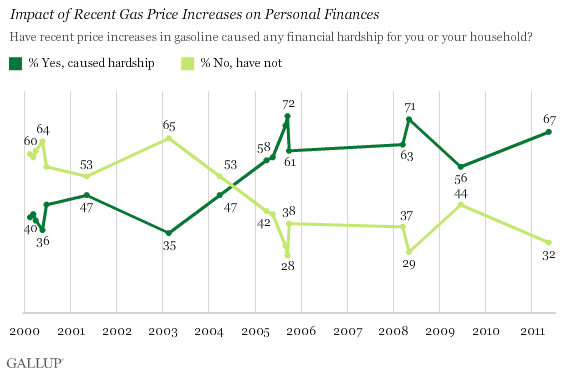PRINCETON, NJ -- The slight majority of Americans, 53%, say they have responded to today's steep gas prices by making major changes in their personal lives, while 46% say they have not. Sizable proportions of adults of all major income levels have made such changes, including 68% of low-income Americans, 54% of middle-income Americans, and 44% of upper-income Americans.

Although employed Americans are more likely to report driving an above-average amount -- and are thus greater consumers of gasoline -- they are less likely than non-employed Americans to have made major lifestyle changes to deal with rising gas prices, 49% vs. 58%. This likely reflects the higher average income of employed Americans, but may also indicate they have less flexibility in their lives to cut back on driving.
These findings come from a USA Today/Gallup poll conducted May 12-15, in which 67% of Americans say the recent high gas prices have caused them financial hardship, including 21% who say they have caused them severe hardship. This is among the highest levels of reported hardship Gallup has seen on this measure since 2000, and is similar to the 71% found when average gas prices nationwide topped $4 per gallon in 2008 and the 72% when they first exceeded $3 per gallon in 2005.

Americans Driving Less, Steering Toward Cars That Are More Fuel Efficient
Among the 53% of Americans who report having made major changes in their lives to deal with gas prices, the most common strategy, mentioned by a third of them, is simply driving less. Additionally, 16% specifically report they are cutting back on vacation travel, 15% are being more careful in planning errands and other local trips, and 15% have either purchased a more fuel-efficient vehicle or are looking into it. Smaller segments are doing less "leisure driving," carpooling, using public transportation, walking more, biking more, and driving more slowly.
Rather than driving less, 12% of those making major changes due to gas prices say they are cutting back on groceries, clothes, and other expenses to absorb the higher gas costs.

Low-income Americans who have made major lifestyle changes due to high gas prices primarily report significant hardships, including driving less and cutting back on household expenses. By contrast, those in middle- and upper-income households are relatively more likely to report driving less for vacations and errands.
Additionally, while equal percentages of men and women say they are driving less in response to changes in gas prices, men are nearly twice as likely as women to say they have purchased or plan to purchase a more fuel-efficient car, 20% vs. 11%. Women, on the other hand, are twice as likely (16% vs. 8%) to say they have cut back on other household expenses.
The responses of adults who have made changes to deal with high gas prices vary by age, with those 55 and older much more likely than younger adults to say they have been more careful about running errands but less likely to say they are using a more fuel-efficient car.
Bottom Line
Average gas prices in the United States have increased by nearly $1 a gallon since January, with half of that increase occurring since March. This increase has clearly caught Americans' attention, with 67% saying it has caused them financial hardship. Additionally, the slight majority of Americans report that they have made real changes in their lives to deal with high fuel costs. Driving less is the obvious, and most common, response, whether that be driving less in general, cutting back on vacation travel, or consolidating errands. Additionally, some Americans, particularly those under 55, have switched to a more fuel-efficient car, while others, particularly lower-income Americans, have cut back on other household and living expenses to be able to put gas in their tanks.
Survey Methods
Results for this USA Today/Gallup poll are based on telephone interviews conducted May 12-15, 2011, with a random sample of 1,024 adults, aged 18 and older, living in all 50 U.S. states and the District of Columbia.
For results based on the total sample of national adults, one can say with 95% confidence that the maximum margin of sampling error is ±4 percentage points.
For results based on the sample of 484 adults employed full- or part-time, one can say with 95% confidence that the maximum margin of sampling error is ±5 percentage points.
Interviews are conducted with respondents on landline telephones and cellular phones, with interviews conducted in Spanish for respondents who are primarily Spanish-speaking. Each sample includes a minimum quota of 400 cell phone respondents and 600 landline respondents per 1,000 national adults, with additional minimum quotas among landline respondents for gender within region. Landline telephone numbers are chosen at random among listed telephone numbers. Cell phones numbers are selected using random digit dial methods. Landline respondents are chosen at random within each household on the basis of which member had the most recent birthday.
Samples are weighted by gender, age, race, Hispanic ethnicity, education, region, adults in the household, and phone status (cell phone-only/landline only/both, cell phone mostly, and having an unlisted landline number). Demographic weighting targets are based on the March 2010 Current Population Survey figures for the aged 18 and older non-institutionalized population living in U.S. telephone households. All reported margins of sampling error include the computed design effects for weighting and sample design.
In addition to sampling error, question wording and practical difficulties in conducting surveys can introduce error or bias into the findings of public opinion polls.
View methodology, full question results, and trend data.
For more details on Gallup's polling methodology, visit www.gallup.com.
